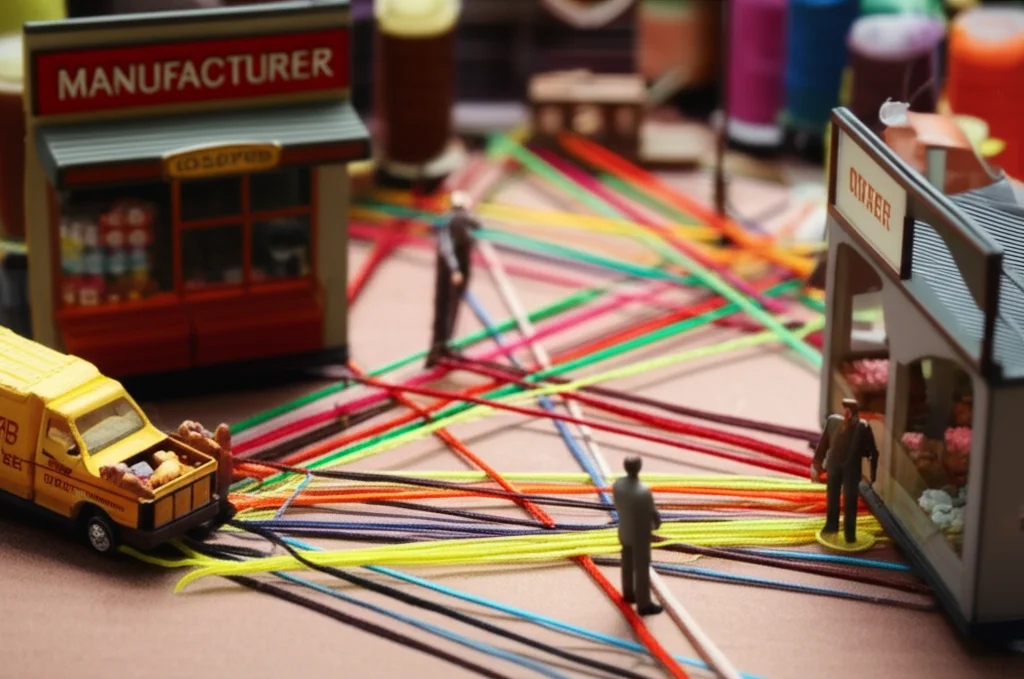Boosting Profit and Saving the Planet: The Smart Way to Run a Supply Chain
Hey There! Let’s Talk Business and the Planet
So, you know how we’re all using more stuff, right? More stuff means we need more raw materials, and honestly, that creates a ton of waste and isn’t exactly great for Mother Earth, especially with all those greenhouse gases floating around. It’s a big problem, and traditional ways of doing business just aren’t cutting it anymore.
That’s where something super cool comes in: Closed-Loop Supply Chains (CLSCs). Think of it like this – instead of just making something, selling it, and then it ends up in a landfill, a CLSC brings products back after use. They get collected, maybe fixed up (remanufactured), or broken down for parts (recycled), and then those materials go back into making new stuff. It’s like a circle, not a straight line to the trash.
Now, while CLSCs are definitely the way forward, a lot of the existing ideas on how to run them perfectly haven’t really put everything together. They might look at prices, or maybe just carbon emissions, but they often miss the bigger picture. What about what customers *really* want? How do the different companies involved (like the guys making the stuff, the shops selling it, the folks collecting old products, and the recyclers) work together? And how does all this play out over time, not just in one snapshot?
That’s exactly what got us thinking! We wanted to figure out the absolute best way for a CLSC to make the most money *and* slash those carbon emissions. We focused on a setup with four key players – the Manufacturer (who makes the new stuff), the Retailer (who sells it), the Collector (who gathers the used stuff), and the Recycler (who breaks it down or preps it for remanufacturing). We looked at this over two periods, because let’s be real, business isn’t a one-and-done deal.
We used a fancy tool called the Stackelberg game-theoretic approach. Don’t let the name scare you! It’s basically a way to model how players make decisions when some are leaders and others are followers. We tested out seven different ways these four players could team up (alliances) and compared them to just everyone doing their own thing (the baseline). The results? Pretty eye-opening!
The Players in Our Closed-Loop Game
Imagine our supply chain as a small ecosystem. In the first period, it’s pretty standard: the Manufacturer makes new products, sells them wholesale to the Retailer, and the Retailer sells them to you, the customer. Simple enough.
But the second period is where the magic (and the complexity!) happens. Now we’ve got used products floating around. Some can be remanufactured – fixed up to be almost like new, but usually sold for less. Others are recyclable – they can’t be fixed, but their materials can be used again. These recyclable ones are what we called “green products” in this context, because using recycled materials is a big win for reducing emissions.
Enter the other two players: the Collector and the Recycler. The Collector buys used products back from consumers. They pay a bit for the ones that can be remanufactured and a bit for the ones that are just for recycling. The Retailer then buys the remanufacturable ones from the Collector to fix up and resell. The Recycler buys the recyclable ones from the Collector, processes them, and sells the recycled materials back to the Manufacturer. The Manufacturer then uses these recycled materials (maybe with some new ones) to make those “green products” for the second period, selling them wholesale to the Retailer, who sells them to consumers.
It’s a bit of a loop-de-loop, right? Manufacturer -> Retailer -> Consumer -> Collector -> (Retailer for remanufactured / Recycler for recyclable) -> (Retailer for remanufactured / Manufacturer for green) -> Consumer. Phew!
We modeled all these relationships, with the Manufacturer usually taking the lead in setting prices and investment levels, especially for things like reducing carbon emissions.

Teaming Up for Success: The Alliance Game
Okay, so we have our players and the game board (the two-period CLSC). Now, how do they play together? We didn’t just look at everyone doing their own thing (the baseline). We explored seven different ways they could form alliances:
- Manufacturer and Recycler team up (focus on green products, recycling, emissions).
- Retailer and Collector team up (focus on gathering and recycling materials).
- Manufacturer, Recycler, Retailer, and Collector all team up (the big one!).
- Recycler and Collector team up (focus on gathering and recycling).
- Manufacturer, Collector, and Recycler team up (gathering, green products, emissions).
- Retailer, Collector, and Recycler team up (gathering and remanufacturing).
- All four players team up (the ultimate collaboration!).
For each of these scenarios, we crunched the numbers to see what the optimal decisions would be for things like prices (wholesale and retail), how much to invest in cutting carbon emissions, and ultimately, how much profit everyone makes and how many emissions are reduced.
The Big Reveal: Which Alliance Wins?
Alright, drumroll please… Which alliance came out on top for both profit and the planet? It was the seventh alliance – the one where all four players worked together! This wasn’t just a small win; it was a massive improvement.
Compared to the baseline (everyone for themselves), the seventh alliance boosted the total profit by a whopping 71.16%! That’s huge! And it wasn’t just about money. This full collaboration also led to a significant reduction in carbon emissions – 44.84 units less, to be exact. This really shows that you don’t have to choose between making money and being environmentally responsible; you can do both, especially when you team up effectively.
Why did this alliance work so well? Well, when everyone’s on the same page, they can share the costs of things like investing in carbon reduction and optimize logistics for collecting and processing used products. We saw a 15.3% reduction in marginal costs and even better supply chain resilience, with demand fluctuations reduced by 12.7%. It’s like a well-oiled machine when all the parts work together.
What About the Customers? They Matter!
One of the really interesting things we looked at was how much consumers care about carbon reduction. We found that if consumers become more sensitive to this (say, their sensitivity goes from 0.3 to 0.9 on our scale), something amazing happens: demand for green products jumps by 19.2%, and overall profit climbs by 14.8%! This tells us that investing in sustainability isn’t just good for the planet; it’s a smart business move because customers are increasingly willing to support companies that are making an effort.

Diving Deeper: What the Numbers Tell Us
We played around with our model, changing different factors to see how the results shifted. This is called sensitivity analysis, and it gives us even more insights.
For example, we saw that how well products sold in the first period had a big impact on the second period. If demand was higher initially, it generally meant higher profits later, especially for the alliances where the manufacturer and retailer worked closely.
On the flip side, if costs went up – like the cost to produce green products or the cost of recycling – profits tended to drop. This makes sense, right? But some alliances, particularly those involving recyclers and diversified sourcing, were more resistant to these cost increases. It highlights the importance of efficient operations in the recycling and remanufacturing steps.
We also looked at how sensitive consumers are to the difference between green and remanufactured products, and their overall sensitivity to carbon reduction efforts. We found there’s a sweet spot for consumer sensitivity to the competition between green and remanufactured products (when our parameter λ is between 0.5 and 1, and δ is between 0 and 0.5). In this range, demand for *both* types of products is maximized, leading to higher profits. It’s about offering choices that resonate with conscious consumers.
And as we mentioned, increasing consumer sensitivity to carbon reduction (γ) was a major driver. The more customers cared, the more companies invested in reducing emissions, and the more demand and profit grew. This was most pronounced in the full collaboration alliance (the seventh one), showing that when the whole chain is committed, the positive impact is amplified.

Putting Insights into Action
So, what does all this mean for people running businesses or making policies?
For business leaders, the message is clear: Embrace CLSCs! Don’t just think about selling new products. Think about the whole lifecycle. And seriously consider strategic alliances with your supply chain partners – manufacturer, retailer, collector, and recycler. Our study strongly suggests that full collaboration is the most profitable and sustainable path.
Pay attention to your customers! They increasingly care about sustainability. Use dynamic pricing that reflects the value of green and remanufactured products. Invest in reducing your carbon footprint and tell your customers about it – sustainability-focused marketing works!
For policymakers, this research provides solid ground for creating incentives. Think about carbon pricing policies, tax incentives for recycling and remanufacturing, and regulations that encourage businesses to adopt these closed-loop practices. Policies that support collaboration across the supply chain could be particularly effective.
Implementing these strategies helps companies not just meet environmental goals but also achieve economic ones. It builds a great brand image, attracts environmentally conscious consumers, and can lead to more stable production and higher profits. It’s a win-win-win: for the company, the customer, and the planet.
Looking Ahead
This study gives us a fantastic starting point, but there’s always more to explore! We looked at two periods, but real supply chains run continuously. Future research could look at multi-period or even unpredictable (stochastic) environments to get an even clearer picture.
We could also dive deeper into different types of consumers – do some groups care more about price, while others prioritize environmental impact? Understanding these differences could help companies tailor their strategies even better.
And of course, technology is always changing! How will new recycling techniques or digital tools like blockchain (for tracking products and emissions transparently) fit into these models? Lots of exciting possibilities!
Ultimately, our work here highlights that in the world of supply chains, collaboration isn’t just nice to have; it’s a powerful strategy for maximizing profit while seriously reducing environmental impact. It’s about building a future where business success and sustainability go hand in hand.
Source: Springer







